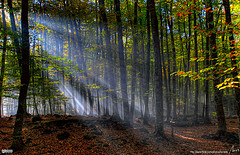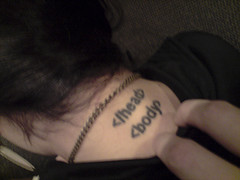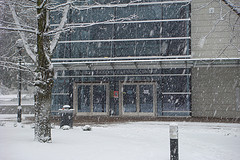February 6th, 2009 by Kevin Lindstrom | No Comments »
The University of British Columbia Library and Springer are delighted to introduce a new Print on Demand feature linked to the Library’s eBook collection: MyCopy powered by SpringerLink.
As a current faculty member of the University of British Columbia, MyCopy allows you to order your own personal print copy of a Springer eBook included in the Library’s collection. The individual copy will be delivered as a printed soft cover version directly to your doorstep. Best of all, it will be available to all patrons for just $24.95 (USD plus GST & PST, including shipping and handling costs).
The University of British Columbia Library is one of the first libraries to introduce the MyCopy service that includes more than 11,000 eBooks out of a total of 30,000 eBooks available on SpringerLink. We invite you to take a look, browse this comprehensive eBook collection and take advantage of the MyCopy service.
If you find an eBook that you would like to use for a course, you can simply copy the URL in the address bar on SpringerLink and add this to your course syllabus. The students can then follow the URL and purchase the eBook directly on http://www.springerlink.com for home delivery.
Below are directions for ordering a MyCopy book for just $24.95 (USD plus GST & PST, including shipping and handling costs)
1. Go to SpringerLink: http://www.springerlink.com
2. Search or browse eBooks in your research area (Available titles will have an orange MyCopy label associated with it.)
3. Click on the eBook or eBook chapter of your interest
4. Click on the MyCopy Logo found underneath the eBook or eBook chapter information, or the “add to shopping cart now” link within the orange box on the right hand column to start the ordering process.
We trust you will find this feature a valuable addition to Springer’s eBook collection. If you have questions, comments, or suggestions, please do not hesitate to contact UBC Librarians Joy Kirchner (joy.kirchner@ubc.ca) and Aleteia Greenwood (aleteia.greenwood@ubc.ca) or Springer at http://www.springerlink.com/feedback.
For a complete list of all Springer Ebooks including MyCopy titles go to the Springer eBooks by Subject Collection page and download the Excel spreadsheet for your discipline. Look for the column that contains the Springerlink openurl and paste this url into your browser.
Submitted by Kevin Lindstrom Liaison Librarian for the Physical and Applied Sciences.
Posted in Atmospheric Science, Chemical and Biological Engineering, Chemistry, Civil Engineering, Earth and Ocean Sciences, General Science, Geography, Main, Materials Engineering, Mathematics, Mechanical Engineering, News, Physics, Science - undegraduate classes, Statistics, Wood Sciences | No Comments »
February 4th, 2009 by Eugene Barsky | No Comments »

This is a quick post to remind you about various standards we have in the SciEng library:
* ASTM up to 2006
* CSA and ANSI standards up to 1995 (How to get those?)
* IEEE Standards: The IEEE Electronic Library provides access to over 1,000 current, revised and superceded standards in the field of electrical and computer engineering. You must be a UBC faculty, student or staff to access these resources. Print standards can be found in the UBC Library catalogue, though coverage varies.
* ISO: We own a number of ISO standards that are listed individually in our library catalogue, mostly from the early 1990s. Try typing ISO and standard? in catalogue search box.
* Open Access Standards (Free):
a.International Telecommunications Union (ITU-T)
b. International Organization for Standardization (ISO) and International Electrotechnical Commission (IEC) Standards. The Standards Council of Canada will grant a license for use of ISO and IEC international standards by recognized Canadian educational institutions in a credit course. Please contact us to learn more about this option.
Please do not hesitate to contact Kevin Lindstrom or Eugene Barsky if you require any additional info!
** Photo by Sifter
Posted in Atmospheric Science, Chemical and Biological Engineering, Chemistry, Civil Engineering, Earth and Ocean Sciences, General Science, Geography, Main, Materials Engineering, Mathematics, Mechanical Engineering, Physics, Science - undegraduate classes, Statistics, Wood Sciences | No Comments »
January 30th, 2009 by Kevin Lindstrom | No Comments »
Antique Plutonium
Manhattan Project-era plutonium is found in a glass jug during Hanford Site cleanup.
One of the oldest known samples of plutonium has been dug up from a waste trench in Hanford, Wash., near the now-decommissioned nuclear production site along the Columbia River. During the process of figuring out the plutonium’s origin and history, a new technique emerged that may help nuclear scientists identify the age and source of trafficked nuclear material.
For the full article, go to Latest News section of Chemical and Engineering News.
Submitted by Kevin Lindstrom Liaison Librarian for Chemistry and Physics
Posted in Chemical and Biological Engineering, Chemistry, Earth and Ocean Sciences, General Science, Physics, Science - undegraduate classes | No Comments »
January 27th, 2009 by Eugene Barsky | No Comments »
This well-edited little video does a good job of tracing the rise of the internet from early networking efforts to birth of the TCP/IP protocol.
History of the Internet from PICOL on Vimeo.
UBC Library has a number of books on this topic as well. Try searching for Internet AND history in our library catalogue.
Posted in Main, Science - undegraduate classes | No Comments »
January 23rd, 2009 by Kevin Lindstrom | No Comments »
Here’s a recent article by UBC Physics and Astronomy researchers Zibin, Moss, and Scott
Can we avoid dark energy? Zibin, James P. Moss, Adam; Scott, Douglas.Physical Review Letters, 101(25) p. 251303 2008.
Abstract: The idea that we live near the center of a large, nonlinear void has attracted attention recently as an alternative to dark energy or modified gravity. We show that an appropriate void profile can fit both the latest cosmic microwave background and supernova data. However, this requires either a fine-tuned primordial spectrum or a Hubble rate so low as to rule these models out. We also show that measurements of the radial baryon acoustic scale can provide very strong constraints. Our results present a serious challenge to void models of acceleration.
Need more background information on Einstein-de Sitter spacetime? Or the Friedmann-Lemaitre model?
Have a look at the Encyclopedia of Astronomy and Astrophysics
A search of Springer’s ebook collection for Einstein-de Sitter gives the following results.
For additional ebooks on the topic, have a quick browse of Springer’s Physics and Astronomy collection.
Need a comprehensive list of databases, ejournals and related resources? Check out the Science and Engineering subject guides for Astronomy and Physics.
Submitted by Kevin Lindstrom Liaison Librarian for Physics and Astronomy
Posted in General Science, Mathematics, Physics, Science - undegraduate classes | No Comments »
January 20th, 2009 by Eugene Barsky | No Comments »

From the Food and Agriculture Organization of United Nations (FAO) website:
http://www.fao.org/forestry/52980/en/
This 17-minute video presentation, produced by FAO and the Forestry Commission of the United Kingdom, shows how much forests can contribute to the mitigation of climate change, stressing the importance of reversing forest loss.
Forests store more carbon than all the world’s remaining oil stocks. Continuing deforestation and forest degradation account for almost one-fifth of the world’s greenhouse gas emissions – more than the entire global transport sector. The presentation explains how society can combat climate change by conserving and managing existing forests, by tackling causes of deforestation and by planting new forests. It stresses the use of wood as a renewable energy source and as a raw material, pointing out that wood products store carbon for their entire lifetime, until they decay or are burned. A section on adaptation notes how the world’s changing climate will affect the health and composition of forests and stresses the importance of adapting and planning ahead for the changes.
** Photo by MorBCN
Posted in Earth and Ocean Sciences, Main, Science - undegraduate classes, Wood Sciences | No Comments »
January 15th, 2009 by Eugene Barsky | No Comments »

The US National Security Agency has helped put together a list of the world’s most dangerous coding mistakes.
Experts from more than 30 US and international cyber security organizations jointly released the consensus list of the 25 most dangerous programming errors that lead to security bugs and that enable cyber espionage and cyber crime. Shockingly, most of these errors are not well understood by programmers; their avoidance is not widely taught by computer science programs; and their presence is frequently not tested by organizations developing software for sale.
BBC news article lists the mistakes here – http://news.bbc.co.uk/2/hi/technology/7824939.stm
** Photo by Marco Gomes
Posted in Amusing stuff, Main, Mathematics, News, Science - undegraduate classes | No Comments »
December 24th, 2008 by Eugene Barsky | No Comments »

We would like to wish you happy holidays! We are looking forward to work with many of you next year!
Enjoy the snow 🙂
** Photo by velkr0
Posted in Atmospheric Science, Chemical and Biological Engineering, Chemistry, Civil Engineering, Earth and Ocean Sciences, General Science, Geography, Main, Materials Engineering, Mathematics, Mechanical Engineering, News, Physics, Science - undegraduate classes, Statistics, Wood Sciences | No Comments »
December 22nd, 2008 by Kevin Lindstrom | No Comments »
Environment Canada operates the National Climate Data and Information Archive. The Archive contains the official climate and weather observations for Canada.
Direct access to climate and weather values in the database is available at Climate Data Online. Use this area to find out what the weather was like on a particular day, for a month, or for a whole year.
The Canadian Climate Normals contain averages and extremes for nearly 1,500 locations across Canada. Use this area to find out about the conditions usually found at a location at different times of the year.
Canadian Daily Climate Data (CDCD). The 2006/7 CDCD containing daily temperature, precipitation and snow-on-the-ground data is available for download.
Data files can be download in CSV or XML format for further analysis.
Submitted by Kevin Lindstrom, Liaison Library for Earth and Ocean Sciences
Posted in Atmospheric Science, Earth and Ocean Sciences, General Science, Geography, Science - undegraduate classes | No Comments »
December 18th, 2008 by Eugene Barsky | No Comments »

The new Pew Report on Future of Internet III was released a few days ago.
A survey of experts shows they expect major tech advances as the phone becomes a primary device for online access, voice-recognition improves, and the structure of the Internet itself improves. They disagree about whether this will lead to more social tolerance, more forgiving human relations, or better home lives.
http://pewinternet.org/pdfs/PIP_FutureInternet3.pdf
Major findings from the report:
• The mobile device will be the primary connection tool to the Internet for most people in the world in 2020.
• The transparency of people and organizations will increase, but that will not necessarily yield more personal integrity, social tolerance, or forgiveness.
• Voice recognition and touch user-interfaces with the Internet will be more prevalent and accepted by 2020.
• Those working to enforce intellectual property law and copyright protection will remain in a continuing “arms race,” with the “crackers” who will find ways to copy and share content without payment.
• The divisions between personal time and work time and between physical and virtual reality will be further erased for everyone who’s connected, and the results will be mixed in terms of social relations.
• “Next-generation” engineering of the network to improve the current Internet architecture is more likely than an effort to rebuild the architecture from scratch.
** Photo by Myxi
Posted in General Science, Main, News, Science - undegraduate classes | No Comments »





